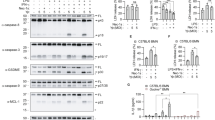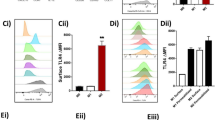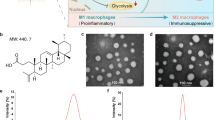Abstract
Emerging concepts suggest that the functional phenotype of macrophages is regulated by transcription factors that define alternative activation states. We found that RBP-J, the main nuclear transducer of signaling via Notch receptors, augmented Toll-like receptor 4 (TLR4)-induced expression of key mediators of classically activated M1 macrophages and thus of innate immune responses to Listeria monocytogenes. Notch–RBP-J signaling controlled expression of the transcription factor IRF8 that induced downstream M1 macrophage–associated genes. RBP-J promoted the synthesis of IRF8 protein by selectively augmenting kinase IRAK2–dependent signaling via TLR4 to the kinase MNK1 and downstream translation-initiation control through eIF4E. Our results define a signaling network in which signaling via Notch–RBP-J and TLRs is integrated at the level of synthesis of IRF8 protein and identify a mechanism by which heterologous signaling pathways can regulate the TLR-induced inflammatory polarization of macrophages.
This is a preview of subscription content, access via your institution
Access options
Subscribe to this journal
Receive 12 print issues and online access
$259.00 per year
only $21.58 per issue
Buy this article
- Purchase on SpringerLink
- Instant access to full article PDF
Prices may be subject to local taxes which are calculated during checkout








Similar content being viewed by others
References
Mosser, D.M. & Edwards, J.P. Exploring the full spectrum of macrophage activation. Nat. Rev. Immunol. 8, 958–969 (2008).
Krausgruber, T. et al. IRF5 promotes inflammatory macrophage polarization and TH1–TH17 responses. Nat. Immunol. 12, 231–238 (2011).
Satoh, T. et al. The Jmjd3-Irf4 axis regulates M2 macrophage polarization and host responses against helminth infection. Nat. Immunol. 11, 936–944 (2010).
Tailor, P. et al. The feedback phase of type I interferon induction in dendritic cells requires interferon regulatory factor 8. Immunity 27, 228–239 (2007).
Holtschke, T. et al. Immunodeficiency and chronic myelogenous leukemia-like syndrome in mice with a targeted mutation of the ICSBP gene. Cell 87, 307–317 (1996).
Liu, J., Guan, X., Tamura, T., Ozato, K. & Ma, X. Synergistic activation of interleukin-12 p35 gene transcription by interferon regulatory factor-1 and interferon consensus sequence-binding protein. J. Biol. Chem. 279, 55609–55617 (2004).
Xiong, H. et al. Complex formation of the interferon (IFN) consensus sequence-binding protein with IRF-1 is essential for murine macrophage IFN-γ-induced iNOS gene expression. J. Biol. Chem. 278, 2271–2277 (2003).
Giese, N.A. et al. Interferon (IFN) consensus sequence-binding protein, a transcription factor of the IFN regulatory factor family, regulates immune responses in vivo through control of interleukin 12 expression. J. Exp. Med. 186, 1535–1546 (1997).
Wang, H. & Morse, H.C. III. IRF8 regulates myeloid and B lymphoid lineage diversification. Immunol. Res. 43, 109–117 (2009).
Tamura, T. & Ozato, K. ICSBP/IRF-8: its regulatory roles in the development of myeloid cells. J. Interferon Cytokine Res. 22, 145–152 (2002).
Smale, S.T. Selective transcription in response to an inflammatory stimulus. Cell 140, 833–844 (2010).
Anderson, P. Post-transcriptional regulons coordinate the initiation and resolution of inflammation. Nat. Rev. Immunol. 10, 24–35 (2010).
Mazumder, B., Li, X. & Barik, S. Translation control: a multifaceted regulator of inflammatory response. J. Immunol. 184, 3311–3319 (2010).
Kopan, R. & Ilagan, M.X. The canonical Notch signaling pathway: unfolding the activation mechanism. Cell 137, 216–233 (2009).
Yuan, J.S., Kousis, P.C., Suliman, S., Visan, I. & Guidos, C.J. Functions of notch signaling in the immune system: consensus and controversies. Annu. Rev. Immunol. 28, 343–365 (2010).
Caton, M.L., Smith-Raska, M.R. & Reizis, B. Notch-RBP-J signaling controls the homeostasis of CD8− dendritic cells in the spleen. J. Exp. Med. 204, 1653–1664 (2007).
Hu, X. et al. Integrated regulation of Toll-like receptor responses by Notch and interferon-gamma pathways. Immunity 29, 691–703 (2008).
Monsalve, E. et al. Notch-1 up-regulation and signaling following macrophage activation modulates gene expression patterns known to affect antigen-presenting capacity and cytotoxic activity. J. Immunol. 176, 5362–5373 (2006).
Zhou, J., Cheng, P., Youn, J.I., Cotter, M.J. & Gabrilovich, D.I. Notch and wingless signaling cooperate in regulation of dendritic cell differentiation. Immunity 30, 845–859 (2009).
Foldi, J. et al. Autoamplification of Notch signaling in macrophages by TLR-induced and RBP-J-dependent induction of Jagged1. J. Immunol. 185, 5023–5031 (2010).
Wang, Y.C. et al. Notch signaling determines the M1 versus M2 polarization of macrophages in antitumor immune responses. Cancer Res. 70, 4840–4849 (2010).
Klinakis, A. et al. A novel tumour-suppressor function for the Notch pathway in myeloid leukaemia. Nature 473, 230–233 (2011).
Zhao, B., Grimes, S.N., Li, S., Hu, X. & Ivashkiv, L.B. TNF-induced osteoclastogenesis and inflammatory bone resorption are inhibited by transcription factor RBP-J. J. Exp. Med. 209, 319–334 (2012).
Outtz, H.H., Wu, J.K., Wang, X. & Kitajewski, J. Notch1 deficiency results in decreased inflammation during wound healing and regulates vascular endothelial growth factor receptor-1 and inflammatory cytokine expression in macrophages. J. Immunol. 185, 4363–4373 (2010).
Serbina, N.V., Jia, T., Hohl, T.M. & Pamer, E.G. Monocyte-mediated defense against microbial pathogens. Annu. Rev. Immunol. 26, 421–452 (2008).
Swiatek, P.J., Lindsell, C.E., del Amo, F.F., Weinmaster, G. & Gridley, T. Notch1 is essential for postimplantation development in mice. Genes Dev. 8, 707–719 (1994).
Murtaugh, L.C., Stanger, B.Z., Kwan, K.M. & Melton, D.A. Notch signaling controls multiple steps of pancreatic differentiation. Proc. Natl. Acad. Sci. USA 100, 14920–14925 (2003).
Plevy, S.E., Gemberling, J.H., Hsu, S., Dorner, A.J. & Smale, S.T. Multiple control elements mediate activation of the murine and human interleukin 12 p40 promoters: evidence of functional synergy between C/EBP and Rel proteins. Mol. Cell Biol. 17, 4572–4588 (1997).
Grumont, R. et al. c-Rel regulates interleukin 12 p70 expression in CD8+ dendritic cells by specifically inducing p35 gene transcription. J. Exp. Med. 194, 1021–1032 (2001).
Xie, Q.W., Kashiwabara, Y. & Nathan, C. Role of transcription factor NF-κB/Rel in induction of nitric oxide synthase. J. Biol. Chem. 269, 4705–4708 (1994).
Masumi, A., Tamaoki, S., Wang, I.M., Ozato, K. & Komuro, K. IRF-8/ICSBP and IRF-1 cooperatively stimulate mouse IL-12 promoter activity in macrophages. FEBS Lett. 531, 348–353 (2002).
Ramirez-Carrozzi, V.R. et al. Selective and antagonistic functions of SWI/SNF and Mi-2beta nucleosome remodeling complexes during an inflammatory response. Genes Dev. 20, 282–296 (2006).
Zhang, J. et al. Activation of IL-27 p28 gene transcription by interferon regulatory factor 8 in cooperation with interferon regulatory factor 1. J. Biol. Chem. 285, 21269–21281 (2010).
Kantakamalakul, W. et al. Regulation of IFN consensus sequence binding protein expression in murine macrophages. J. Immunol. 162, 7417–7425 (1999).
Zhao, J. et al. IRF-8/interferon (IFN) consensus sequence-binding protein is involved in Toll-like receptor (TLR) signaling and contributes to the cross-talk between TLR and IFN-γ signaling pathways. J. Biol. Chem. 281, 10073–10080 (2006).
Xiong, H. et al. Ubiquitin-dependent degradation of interferon regulatory factor-8 mediated by Cbl down-regulates interleukin-12 expression. J. Biol. Chem. 280, 23531–23539 (2005).
Ueda, T., Watanabe-Fukunaga, R., Fukuyama, H., Nagata, S. & Fukunaga, R. Mnk2 and Mnk1 are essential for constitutive and inducible phosphorylation of eukaryotic initiation factor 4E but not for cell growth or development. Mol. Cell. Biol. 24, 6539–6549 (2004).
Wan, Y. et al. Interleukin-1 receptor-associated kinase 2 is critical for lipopolysaccharide-mediated post-transcriptional control. J. Biol. Chem. 284, 10367–10375 (2009).
Joshi, S. et al. Essential role for Mnk kinases in type II interferon (IFNγ) signaling and its suppressive effects on normal hematopoiesis. J. Biol. Chem. 286, 6017–6026 (2011).
Flannery, S.M., Keating, S.E., Szymak, J. & Bowie, A.G. Human interleukin-1 receptor-associated kinase-2 is essential for Toll-like receptor-mediated transcriptional and post-transcriptional regulation of tumor necrosis factor α. J. Biol. Chem. 286, 23688–23697 (2011).
Kawagoe, T. et al. Sequential control of Toll-like receptor-dependent responses by IRAK1 and IRAK2. Nat. Immunol. 9, 684–691 (2008).
Waskiewicz, A.J., Flynn, A., Proud, C.G. & Cooper, J.A. Mitogen-activated protein kinases activate the serine/threonine kinases Mnk1 and Mnk2. EMBO J. 16, 1909–1920 (1997).
Conner, J.R., Smirnova, II & Poltorak, A. A mutation in Irak2c identifies IRAK-2 as a central component of the TLR regulatory network of wild-derived mice. J. Exp. Med. 206, 1615–1631 (2009).
Osipo, C., Golde, T.E., Osborne, B.A. & Miele, L.A. Off the beaten pathway: the complex cross talk between Notch and NF-κB. Lab. Invest. 88, 11–17 (2008).
Shin, H.M. et al. Notch1 augments NF-κB activity by facilitating its nuclear retention. EMBO J. 25, 129–138 (2006).
Shelton, C.C., Tian, Y., Frattini, M.G. & Li, Y.M. An exo-cell assay for examining real-time γ-secretase activity and inhibition. Mol. Neurodegener. 4, 22 (2009).
Jorissen, E. et al. The disintegrin/metalloproteinase ADAM10 is essential for the establishment of the brain cortex. J. Neurosci. 30, 4833–4844 (2010).
Horiuchi, K. et al. Cutting edge: TNF-α-converting enzyme (TACE/ADAM17) inactivation in mouse myeloid cells prevents lethality from endotoxin shock. J. Immunol. 179, 2686–2689 (2007).
Shi, C. et al. Bone marrow mesenchymal stem and progenitor cells induce monocyte emigration in response to circulating toll-like receptor ligands. Immunity 34, 590–601 (2011).
Wang, H. et al. Genome-wide analysis reveals conserved and divergent features of Notch1/RBPJ binding in human and murine T-lymphoblastic leukemia cells. Proc. Natl. Acad. Sci. USA 108, 14908–14913 (2011).
Acknowledgements
We thank T. Honjo (Kyoto University) for Rbpjflox/flox mice; T. Gridley (Maine Medical Center Research Institute) for Notch1+/− mice; R. Kopan (Washington University) for NICD1 expression plasmids; S. Smale (University of California, Los Angeles) for Il12b promoter reporter constructs; M. Takami (Showa University) for the IRF8 expression construct; S. Akira (Osaka University) for IRAK2 retroviral constructs; J.A. Cooper (Fred Hutchinson Cancer Research Center) for MNK1 expression plasmids; E. Kieff (Harvard Medical School); J.C. Aster (Harvard Medical School) for anti-RBP-J rabbit serum; E.G. Pamer for discussions about the L. monocytogenes infection experiments; and K. Au for technical assistance. Supported by the American College of Rheumatology (X.H.) and the US National Institutes of Health (L.B.I. and X.H.).
Author information
Authors and Affiliations
Contributions
H.X., J.Z., J.F., A.Y.C. and C.S. did experiments and analyzed data; S.S. did experiments, analyzed data and prepared the manuscript. B.Z. generated NICD1M mice, provided the IRF8-expressing retroviral vector and assisted with the experiments with Irf8−/− mice; H.O. and J.K. provided Notch1+/− mice; S.W. and P.S. provided ADAM10-deficient mice; Y.L. provided GSI34; K.O. provided Irf8−/− mice; C.P.B. provided mice with loxP-flanked Adam17 alleles and advice about experiments; L.B.I. provided advice about experiments and contributed to manuscript preparation; and X.H. designed research, supervised experiments and prepared the manuscript.
Corresponding author
Ethics declarations
Competing interests
The authors declare no competing financial interests.
Supplementary information
Supplementary Text and Figures
Supplementary Figures 1–8 (PDF 3622 kb)
Rights and permissions
About this article
Cite this article
Xu, H., Zhu, J., Smith, S. et al. Notch–RBP-J signaling regulates the transcription factor IRF8 to promote inflammatory macrophage polarization. Nat Immunol 13, 642–650 (2012). https://doi.org/10.1038/ni.2304
Received:
Accepted:
Published:
Issue date:
DOI: https://doi.org/10.1038/ni.2304
This article is cited by
-
Disparate macrophage responses are linked to infection outcome of Hantan virus in humans or rodents
Nature Communications (2024)
-
Notch ligands are biomarkers of anti-TNF response in RA patients
Angiogenesis (2024)
-
Roles of Macrophages and Their Interactions with Schwann Cells After Peripheral Nerve Injury
Cellular and Molecular Neurobiology (2024)
-
LncRNA AK089514/miR-125b-5p/TRAF6 axis mediates macrophage polarization in allergic asthma
BMC Pulmonary Medicine (2023)
-
Exosomal circRNA: emerging insights into cancer progression and clinical application potential
Journal of Hematology & Oncology (2023)



